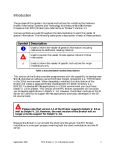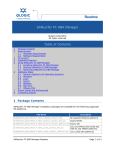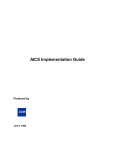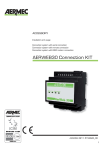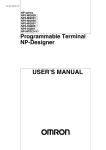Download RPC Broker V. 1.1 Technical Manual
Transcript
Introduction This manual provides information about the structure of the Veterans Health Information Systems and Technology Architecture (VISTA) software known as the Remote Procedure Call (RPC) Broker (also referred to as "Broker"). This manual consists of technical material specifically intended for VISTA systems managers and developers. PRODUCT OVERVIEW The RPC Broker is considered to be part of the infrastructure of VISTA. It establishes a common and consistent foundation for communication between clients and VISTA M servers. The RPC Broker is a bridge connecting the client application front-end on the workstation (e.g., Delphi GUI applications) to the M-based data and business rules on the server. It links one part of a program running on a workstation to its counterpart on the server. The client and the server can be, and most often are, written in different computer languages. Therefore, the RPC Broker bridges the gap between the traditionally proprietary VISTA and COTS/HOST products. The RPC Broker includes: • A common communications driver for the M server interface that handles the device-specific characteristics of the supported communications protocol. • An interface component on the M server, separate from the communications driver, that interprets client messages, executes the required code, and eventually returns data to the communications driver. • A common file on the M server which all applications use to store the information about the queries to which they respond (i.e., REMOTE PROCEDURE file [#8994]). • The Client Agent application that runs on client workstations, supporting single signon. • The TRPCBroker component for Delphi, enabling development of client applications that can communicate via the RPC Broker. • A dynamic link library (DLL) that provides access to RPC Broker functionality for development environments other than Delphi. September 1997 RPC Broker V. 1.1 Technical Manual 1 Introduction RELATED MANUALS AND OTHER REFERENCES Readers who wish to learn more about the RPC Broker should consult the following: • RPC Broker V. 1.1 Getting Started with the Broker Development Kit • RPC Broker V. 1.1 Installation Guide • RPC Broker V. 1.1 Release Notes • RPC Broker V. 1.1 Systems Manual • Online RPC Broker Developer's Guide (i.e., BROKER.HLP) • The MIRMO/ISC Operations Document, "Chapter 10" • Programming Standards and Conventions (SAC) • RPC Broker Home Page at the following web address: http://www.vista.med.va.gov/softserv/infrastr.uct/broker/index.html This site contains additional information and documentation (e.g., Frequently Asked Questions [FAQs]) available in Hypertext Markup Language (HTML). Broker documentation is made available online, on paper, and in Adobe Acrobat Portable Document Format (.PDF). The .PDF documents must be read using the Adobe Acrobat Reader (i.e., ACROREAD.EXE), which is freely distributed by Adobe Systems Incorporated at the following web address: http://www.adobe.com/ For more information on the use of the Adobe Acrobat Reader, please refer to the "Adobe Acrobat Quick Guide" at the following web address: http://www.vista.med.va.gov/softserv/infrastr.uct/acrobat/index.html 2 RPC Broker V. 1.1 Technical Manual September 1997 Implementation and Maintenance The RPC Broker V. 1.1 Installation Guide provides detailed information regarding the installation of the RPC Broker. It also contains many requirements and recommendation regarding how the Broker should be configured. Be sure to read the Installation Guide before attempting to install the RPC Broker. SITE PARAMETERS This topic lists the site parameters that can be set to customize the operation of the RPC Broker. The following two areas of the Broker require site parameter review and configuration: • Broker Listeners • Single Signon Functionality Broker Listeners The RPC BROKER SITE PARAMETERS file (#8994.1) includes a LISTENER field and various subfields. The LISTENER field is a multiple and should contain all Listeners that you plan to run. A simple change of the STATUS subfield from STOPPED to START will start that particular Listener. Conversely, you can STOP a RUNNING Listener the same way. For more information about configuring Broker Listeners, please refer to the RPC Broker V. 1.1 Systems Manual. Single Signon Single signon means that when a user has entered their access and verify code once to create an active connection to the server, they don't need to enter them again to make additional connections. Connections include GUI applications, like CPRS, and also the traditional roll-and-scroll system (through telnet). Fields in the NEW PERSON file (#200) and the KERNEL SYSTEM PARAMETERS file (#8989.3) control access to the single signon feature. For more information about configuring site parameters for single signon, please refer to the RPC Broker V. 1.1 Systems Manual. September 1997 RPC Broker V. 1.1 Technical Manual 3 Implementation and Maintenance PERFORMANCE AND SCALABILITY Current performance statistics are limited. However, results indicate that the processing time and resources consumed by the Broker itself are minimal. The RPC Broker doesn't introduce any additional overhead to the messages sent between the client and the server. Performance should be measured at the application level to determine the amount of resources consumed by VISTA client/server applications that use the Broker. We anticipate collecting more data from this release of the Broker to provide us with comparison statistics on performance and scalability in a production environment that we can pass on to all users of the Broker. 4 RPC Broker V. 1.1 Technical Manual September 1997 File List M SERVER FILES The RPC Broker consists of a single global with two files. This chapter describes the RPC Broker files including the file number, file name, global location, and description of the files. File # File Name Global Location 8994 REMOTE PROCEDURE ^XWB(8994, 8994.1 RPC BROKER SITE PARAMETERS ^XWB(8994.1, Table 2: RPC Broker Files REMOTE PROCEDURE File (#8994) This file is used as a repository of server-based procedures (i.e., remote procedure calls [RPCs]) in the context of the Client/Server architecture. All RPCs used by any site-specific client/server application software using the RPC Broker interface must be registered and stored in this file. Applications running on client workstations can invoke (call) the RPCs in this file to be executed by the server and the results are returned to the client application. Each RPC is associated with an entry point (i.e., ROUTINE with optional TAG). The RPC subfield (#19.05) of the OPTION File (#19) points to RPC field (#.01) of the REMOTE PROCEDURE file (#8994). Data is not distributed with this file. RPCs are distributed and installed as separate components during the installation of the RPC Broker, however. RPC BROKER SITE PARAMETERS file (#8994.1) Site managers can use this file to configure and adjust many characteristics of an RPC Broker installation at a site. Data is not distributed with this file. If you are an MSM 4.3.0 site or greater and using MSERVER instead of the Broker Listener, the current functionality provided by this file is not applicable to your site. September 1997 RPC Broker V. 1.1 Technical Manual 5 File List CLIENT FILES End-User Workstation \Program Files\Vista\Broker Clagent.exe Clagent.hlp RPCTest.exe RPCTest.hlp \Windows\System(32) Bapi32.dll VistaBroker.dpl Programmer Workstation \Program Files\Vista\Broker BrokerProgPref.exe BrokerProgPref.hlp ServerList.exe Serverlsit.hlp \Program Files\Vista\Bdk32\D2 FrmSignonMessage.dcu FrmSignonMessage.dfm Hash.dcu Loginfrm.dcu Loginfrm.dfm MfunStr.dcu RpcbEdtr.dcu RpcbErr.dcu Rpcberr.dfm RpcConf1.dcu Rpcconf1.dfm rpcnet.dcu Rpcnet.dfm SgnonCnf.dcu SgnonCnf.dfm SplVista.dcu Splvista.dfm Trpcb.dcr Trpcb.dcu VCEdit.dcu Vcedit.dfm WSockc.dcu XWBut1.dcu 6 RPC Broker V. 1.1 Technical Manual September 1997 File List \Program Files\Vista\Bdk32\D3 FrmSignonMessage.dcu FrmSignonMessage.dfm Hash.dcu Loginfrm.dcu Loginfrm.dfm MfunStr.dcu RpcbEdtr.dcu RpcbErr.dcu Rpcberr.dfm RpcConf1.dcu Rpcconf1.dfm rpcnet.dcu Rpcnet.dfm SgnonCnf.dcu SgnonCnf.dfm SplVista.dcu Splvista.dfm Trpcb.dcu VCEdit.dcu Vcedit.dfm VistABroker.dcp VistABroker.dpl (same file as in the \Windows\System directory) WSockc.dcu XWBut1.dcu \Program Files\Vista\Bdk32\Doc Broker.cnt Broker.hlp Broker.kwf BrokerSM.cnt BrokerSM.hlp xwb1_1DG.PDF xwb1_1IG.PDF xwb1_1RN.PDF xwb1_1SM.PDF xwb1_1TM.PDF \Program Files\Vista\Bdk32\Headers BAPI32.bas Bapi32.h Bapi32.hpp \Program Files\Vista\Bdk32\Samples\BrokerEx BrokerExample.DPR BrokerExampleAboutFrm.DFM BrokerExampleAboutFrm.PAS BrokerExampleFrm.DFM BrokerExampleFrm.PAS \Program Files\Vista\Bdk32\Samples\Vb5egcho BAPI32.bas egcho.bas Egcho.frm egcho.vbp September 17 RPC Broker V. 1.1 Technical Manual 7 File List 8 RPC Broker V. 1.1 Technical Manual September 1997 Global Translation, Journaling, and Protection TRANSLATION Translation is recommended for the sole RPC Broker global (i.e., ^XWB global). The ^XWB global has the potential to be read-intensive as more and more remote procedures are added to it in the future. For DSM and OpenM Systems: It is best to translate the global to a volume set other than ROU. In order for translation to take effect on DSM and OpenM systems, DSM and OpenM must be rebooted. Cookbook recommendations should also be consulted for suggestions regarding journaling, translation, and replication; the information here may not apply: • DSM for OpenVMS sites should consult the most recent Computer Operations Management and Procedures for AXP Systems (COMPAS) manual. • OpenM sites should refer to the "Configuring OpenM" chapter in the VISTA-NT Conversion Checklist. For MSM Systems: It is best to translate the global to a file server. Cookbook recommendations should also be consulted. MSM sites should consult the most recent 486 Cookbook and MSM System Managers Guide for instructions and recommendations regarding journaling, translation, and replication; the information here may not apply. September 1997 RPC Broker V. 1.1 Technical Manual 9 Global Translation, Journaling, and Protection JOURNALING Journaling of this global is not required, since the ^XWB global, for the most part is static (except during the addition of new remote procedures). PROTECTION The following global protection should be set: Protection Global Name DSM for OpenVMS ^XWB System: RWD Owner: RWD System: RWD World: RW Group: N World: RWD Group: RW World: N Group: RWD User: RW Network: RWD User: RWD OpenM MSM-DOS Table 3: RPC Broker Global Information 10 RPC Broker V. 1.1 Technical Manual September 1997 Routine List This chapter contains a list of the routines exported with the RPC Broker. A brief description of the routines is provided. Routine Description XWBBRK This routine contains calls that are designed to parse the various attributes of the Broker messages. All of this information is used internally. In the case of large arrays sent by the client, the function BREAD is used to read in the variable length subscripts and values. XWBBRK2 This routine is a continuation of XWBBRK. The main entry point (i.e., CAPI) actually calls the application RPC. XWBCAGNT Server code for RPC Broker client agent application. XWBEXMPL This routine is used to support the Broker Example application. The Broker Example application is used to test the RPC Broker connectivity, actions, and RPCs. It is distributed with the Broker. XWBFM This routine contains entry points used to interface to the VA FileMan database server. XWBLIB This routine contains various functions and procedures used by the Broker. It is best described as a library or depository. XWBSEC This routine contains various functions and procedures used by the Broker. Calls in this routine are used for client/server security. XWBTCP This routine contains functions and procedures used to control the Broker TCP/IP Listener process. Systems personnel can use calls in this routine to start, stop, and debug the Broker process. XWBTCPC This job is started for each Broker request. The Listener process (i.e., XWBTCPL) will receive a connection request from a client and then dispatch, using the M JOB command, XWBTCPC to manage the rest of the interaction. XWBTCPL This is the Broker Listener process. IRM starts this job. It remains running on a system listening for TCP/IP connection requests. Once a request is received, this routine will start a separate process to manage the rest of the connection, then returns to "listening" for a new request. September 1997 RPC Broker V. 1.1 Technical Manual 11 Routine List Routine Description XWBZ1 This routine is used to support the Echo application. The Echo application is used to test the RPC Broker connectivity, actions, and APIs. It is distributed with the Broker. ROUTINE MAPPING RPC Broker routines are not required to be mapped to any account. 12 RPC Broker V. 1.1 Technical Manual September 1997 Exported Options The following options are exported with the RPC Broker: Name Menu Text Type XWB BROKER EXAMPLE RPC BROKER PROGRAMMING EXAMPLE Broker (Client/Server) XWB EGCHO RPC BROKER DEMO/TEST Broker (Client/Server) XWB LISTENER STARTER Start RPC Broker Listeners Run Routine XWB RPC TEST RPC Broker (Client/Server) Table 4: Exported Options Client/server applications are a new type of option (i.e., Type "B", Broker client/server options) in the OPTION file (#19). The user must have the client/server application option assigned to them as with any other assigned option in VISTA. The client/server application will only run for those users who are allowed to activate it. The client/server application options will not be displayed in the user's menu tree. XWB BROKER EXAMPLE This option supports the Broker Example demonstration program provided in the Broker Development Kit. Developers should assign this option to themselves, if they want to try out the Broker Example application. For programmers who have the XUPROGMODE key, however, assigning this option to themselves is not necessary. XWB EGCHO This option supports the EGCHO demonstration program provided in the Broker Development Kit. Developers should assign this option to themselves, if they want to try out the EGCHO application. For programmers who have the XUPROGMODE key, however, assigning this option to themselves is not necessary. September 1997 RPC Broker V. 1.1 Technical Manual 13 Exported Options XWB LISTENER STARTER The XWB LISTENER STARTER option can be used to start one or more Broker Listeners at one time. It works in combination with the new CONTROLLED BY LISTENER STARTER (#2) subfield of the Port (#1) subfield of the Listener (#7) multiple field in the RPC BROKER SITE PARAMETERS file (#8994.1). The CONTROLLED BY LISTENER STARTER field is a Yes/No set of codes type field. All of the Listener entries in this file that have CONTROLLED BY LISTENER STARTER set to Yes will be started when the XWB LISTENER STARTER option is run. Additionally, the XWB LISTENER STARTER option can be scheduled through TaskMan such that whenever TaskMan starts up, the listener processes are started. To do this, schedule the XWB LISTENER STARTER option with SPECIAL QUEUING set to STARTUP. This option should only be made available to system managers. XWB RPC TEST It is recommended that the XWB RPC TEST option be given to users running Broker-based VISTA client/server applications. The RPCTEST.EXE program on the client workstation runs the RPC Broker Diagnostic Program. This tool can be used to verify and test the Broker client/server connection and signon process. It displays information about the client and the server and can be a useful debugging tool for IRM. To enable remote troubleshooting by IRM for all users, you can put this option on the Common menu (i.e., System Command Options menu [XUCOMMAND]). This enables any user to run the RPCTEST.EXE program on their workstation at your request. EXPORTED RPCS The RPC Broker distributes the following remote procedure calls (RPCs): XWB CREATE CONTEXT XWB EGCHO BIG LIST XWB EGCHO LIST XWB EGCHO MEMO XWB EGCHO SORT LIST XWB EGCHO STRING XWB EXAMPLE ECHO STRING XWB EXAMPLE GET LIST XWB EXAMPLE SORT NUMBERS XWB EXAMPLE WPTEXT 14 RPC Broker V. 1.1 Technical Manual September 1997 Exported Options XWB GET VARIABLE VALUE XWB FILE LIST XWB FILENAME CHECK XWB GET VARIABLE VALUE XWB RPC LIST September 17 RPC Broker V. 1.1 Technical Manual 15 Exported Options 16 RPC Broker V. 1.1 Technical Manual September 1997 Archiving and Purging ARCHIVING There are no package-specific archiving procedures or recommendations for the RPC Broker ^XWB global or the REMOTE PROCEDURE and RPC BROKER SITE PARAMETERS files. PURGING There are no package-specific purging procedures or recommendations for the RPC Broker ^XWB global or the REMOTE PROCEDURE and RPC BROKER SITE PARAMETERS files. September 1997 RPC Broker V. 1.1 Technical Manual 17 Archiving and Purging 18 RPC Broker V. 1.1 Technical Manual September 1997 Callable Routines The RPC Broker does not provide any callable M routines. However, other programming interfaces are provided (e.g., Delphi component, DLL, Pascal functions, and RPCs). For information on these other programming interfaces, please refer to the "External Interfaces" chapter in this manual. September 1997 RPC Broker V. 1.1 Technical Manual 19 Callable Routines 20 RPC Broker V. 1.1 Technical Manual September 1997 External Interfaces The following external interfaces to RPC Broker functionality are provided: TRPCBROKER COMPONENT The TRPCBroker component provides all functionality needed for client applications to communicate with VISTA M servers via the RPC Broker. The TRPCBroker component is compatible with Borland Delphi 2.0 and greater. For more information on the TRPCBroker component, please refer to the RPC Broker V. 1.1 Getting Started with the Broker Development Kit and Online RPC Broker Developer's Guide manuals. TRPCBROKER DYNAMIC LINK LIBRARY (DLL) The TRPCBroker DLL (BAPI32.DLL) provides access to RPC Broker functionality for development environments other than Delphi. For more information on the TRPCBroker DLL, please refer to the RPC Broker V. 1.1 Getting Started with the Broker Development Kit and Online RPC Broker Developer's Guide manuals. PASCAL FUNCTIONS The following Pascal functions are provided by the TRPCBroker component: • GetServerInfo function • Splash Screen functions: SplashOpen and SplashClose • Piece function • Translate function • Encryption functions: Decrypt and Encrypt For more information on these Pascal functions, please refer to the RPC Broker V. 1.1 Getting Started with the Broker Development Kit and Online RPC Broker Developer's Guide manuals. September 1997 RPC Broker V. 1.1 Technical Manual 21 External Interfaces RPC BROKER REMOTE PROCEDURES The following RPC is provided for use by developers: • XWB GET VARIABLE VALUE For more information, please refer to the RPC Broker V. 1.1 Getting Started with the Broker Development Kit and Online RPC Broker Developer's Guide manuals. 22 RPC Broker V. 1.1 Technical Manual September 1997 External Relations RELATIONSHIP TO OTHER PACKAGES The RPC Broker software has been developed to aid the VISTA development community and Information Resources Management (IRM) and is considered to be part of the infrastructure of VISTA. Other infrastructure products include VA FileMan, Kernel, and MailMan. The RPC Broker will be used by all client applications written as part of VISTA. The RPC Broker fully integrates with VA FileMan V. 21.0 and Kernel V. 8.0. The absence of RPC Broker software on an M server will disable the functioning of any client application that depends on the RPC Broker to communicate with the M Server. It is possible that the use of RPCs will also be extended to non-client applications. In this case, the REMOTE PROCEDURE FILE must be present for those applications to function correctly. RELATIONSHIP WITH KERNEL AND VA FILEMAN Before installing the RPC Broker, Kernel V. 8.0, Kernel Toolkit V. 7.3, and VA FileMan V. 21.0 must be in place and fully patched. RELATIONSHIPS WITH OPERATING SYSTEMS On the client side, it was decided that the 32-bit Microsoft Windows environment would be the supported platform. Thus, the client portions of the RPC Broker are compatible with Microsoft Windows 95 or higher, and Microsoft Windows NT 3.5 or higher. On the server side, the RPC Broker supports the following ANSI M environments: • Digital Standard M (DSM) V6.3-031 for OpenVMS AXP or greater • InterSystems OpenM for NT version 7 • Micronetics Standard M (MSM) for Windows NT, V. 4.2.4 or greater September 1997 RPC Broker V. 1.1 Technical Manual 23 External Relations DBA APPROVALS and DATABASE INTEGRATION AGREEMENTS (DBIAs) To obtain the current list of DBIAs that the RPC Broker is a custodian of: 1. Sign on to the Forum system (forum.va.gov). 2. Go to the DBA menu. 3. Select the Integration Agreements menu. 4. Select the Custodial Package menu. 5. Choose the ACTIVE by Custodial Package option. 6. When this option prompts you for a package, enter RPC BROKER. 7. All current DBIAs for which the RPC Broker package is custodian are listed. To obtain detailed information on a specific integration agreement: 1. Sign on to the Forum system (forum.va.gov). 2. Go to the DBA menu. 3. Select the Integration Agreements menu. 4. Select the Inquire option. 5. When prompted for "INTEGRATION REFERENCES", enter the integration agreement number of the DBIA you would like to display. 6. The option then lists the full text of the DBIA you requested. 24 RPC Broker V. 1.1 Technical Manual September 1997 External Relations To obtain the current list of DBIAs that the RPC Broker is a subscriber to: 1. Sign on to the Forum system (forum.va.gov). 2. Go to the DBA menu. 3. Select the Integration Agreements menu. 4. Select the Subscriber Package menu. 5. Choose the Print ACTIVE by Subscribing Package option. 6. When prompted "START WITH SUBSCRIBING PACKAGE", enter RPC BROKER (in uppercase). When prompted "GO TO SUBSCRIBING PACKAGE", enter RPC BROKER (in uppercase). 7. All current DBIAs to which the RPC Broker package is a subscriber are listed. September 17 RPC Broker V. 1.1 Technical Manual 25 External Relations 26 RPC Broker V. 1.1 Technical Manual September 1997 Internal Relations No options in the RPC Broker product assume that the entry/exit logic of another option has already occurred. September 1997 RPC Broker V. 1.1 Technical Manual 27 Internal Relations 28 RPC Broker V. 1.1 Technical Manual September 1997 Package-wide Variables The RPC Broker does not create any package-wide variables that have received Programming Standards and Conventions Committee (SACC) exemptions. September 1997 RPC Broker V. 1.1 Technical Manual 29 Package-wide Variables 30 RPC Broker V. 1.1 Technical Manual September 1997 Software Product Security SECURITY MANAGEMENT There are no special legal requirements involved in the use of the RPC Broker product. MAIL GROUPS AND ALERTS The RPC Broker does not make use of mail groups or alerts. REMOTE SYSTEMS The M server process of the RPC Broker allows connections from client applications. Connection by those client applications is subject to authentication as any normal logon requires. Client applications can use any remote procedure call (RPC) authorized to the application, if the application is authorized to the signed-on user. Data is typically exchanged between clients and the RPC Broker server. Clients can be anywhere on VA's TCP/IP network. Encryption is used when a user's access and verify codes are sent from the client to the server. In addition, an encryption API is provided for developer use in their own applications to encode and decode messages passed between client and server. Security with the RPC Broker is a four-part process: 1. Client workstations must send a valid connection request to the M Server. 2. Users must have valid Access and Verify codes. 3. Users must be valid users of a VISTA client/server application. 4. Any remote procedure call must be registered and valid for the application being executed. For more information regarding Broker security, please refer to Chapter 2, "Security", in the RPC Broker V. 1.1 Systems Manual. September 1997 RPC Broker V. 1.1 Technical Manual 31 Software Product Security INTERFACING No non-VA products are embedded in or required by the RPC Broker, other than those provided by the underlying operating systems. ELECTRONIC SIGNATURES Electronic signatures are not used within the RPC Broker. SECURITY KEYS There are no specific security keys exported with the RPC Broker software. However, to bypass security for development purposes, we recommend client/server application developers be assigned the XUPROGMODE security key. All users assigned the XUPROGMODE security key can do the following: • Run any VISTA client/server application regardless of whether it is in their menu tree or not, and • Access any RPC without regard to the application context. FILE SECURITY The RPC Broker establishes the following security over its files: Number Name DD RD WR DEL LAYGO AUDIT 8994 REMOTE PROCEDURE @ @ @ @ @ @ 8994.1 RPC BROKER SITE PARAMETERS @ @ @ @ @ @ Table 5: File Security OFFICIAL POLICIES Modification of any part of the RPC Broker software is strongly discouraged. Distribution of the RPC Broker software is unrestricted. 32 RPC Broker V. 1.1 Technical Manual September 1997 Glossary ACCESS CODE A code that, along with the verify code, allows the computer to identify you as a user authorized to gain access to the computer. Your code is greater than six and less than twenty characters long; can be numeric, alphabetic, or a combination of both; and is usually assigned by a site manager or application coordinator. It is used by the Kernel's Sign-on/Security system to identify the user (see Verify Code). ALERTS Brief online notices that are issued to users as they complete a cycle through the menu system. Alerts are designed to provide interactive notification of pending computing activities, such as the need to reorder supplies or review a patient’s clinical test results. Along with the alert message is an indication that the View Alerts common option should be chosen to take further action. ANSI MUMPS The MUMPS programming language is a standard, that is an American National Standard (ANS). MUMPS stands for Massachusetts Utility Multi-programming System and is abbreviated as M. APPLICATION PROGRAMMING INTERFACE (API) Programmer calls provided by the Kernel for use by application programmers. APIs allow programmers to carry out standard computing activities without needing to duplicate Kernel utilities in their own packages. APIs also further DBA goals of system integration by channeling activities, such as adding new users, through a limited number of callable entry points. ARRAY An arrangement of elements in one or more dimensions. An M array is a set of nodes referenced by subscripts that share the same variable name. CALLABLE ENTRY POINT An authorized programmer call that may be used in any VISTA application package. The DBA maintains the list of DBIC-approved entry points. CLIENT A single term used interchangeably to refer to the user, the workstation, and the portion of the program that runs on the workstation. In an object-oriented environment, a client is a member of a group that uses the services of an unrelated group. If the client is on a local area network (LAN), it can share resources with another computer (server). September 1997 RPC Broker V. 1.1 Technical Manual 33 Glossary COMPONENT An object-oriented term used to describe the building blocks of GUI applications. A software object that contains data and code. A component may or may not be visible. These components interact with other components on a form to create the GUI user application interface. COTS Commercial Off-the-Shelf. COTS refers to software packages that can be purchased by the public and used in support of VISTA. DATA DICTIONARY The Data Dictionary is a global containing a description of what kind of data is stored in the global corresponding to a particular file. The data is used internally by VA FileMan for interpreting and processing files. A Data Dictionary (DD) contains the definitions of a file’s elements (fields or data attributes), relationships to other files, and structure or design. Users generally review the definitions of a file's elements or data attributes; programmers review the definitions of a file's internal structure. DBIA Database Integration Agreement, a formal understanding between two or more application packages which describes how data is shared or how packages interact. The DBA maintains a list of DBIAs between package developers, allowing the use of internal entry points or other packagespecific features that are not available to the general programming public. DIRECT MODE UTILITY A programmer call that is made when working in direct programmer mode. A direct mode utility is entered at the M prompt (e.g., >D ^XUP). Calls that are documented as direct mode utilities cannot be used in application package code. 34 RPC Broker V. 1.1 Technical Manual September 1997 Glossary DLL Dynamic Link Library. A DLL allows executable routines to be stored separately as files with a DLL extension. These routines are only loaded when a program calls for them. DLLs provide several advantages: 1. DLLs help save on computer memory, since memory is only consumed when a DLL is loaded. 2. DLLs ease maintenance tasks. Because the DLL is a separate file, any modifications made to the DLL will not affect the operation of the calling program or any other DLL. 3. DLLs help avoid redundant routines. They provide generic functions that can be utilized by a variety of programs. ERROR TRAP A mechanism to capture system errors and record facts about the computing context such as the local symbol table, last global reference, and routine in use. Operating systems provide tools such as the %ER utility. The Kernel provides a generic error trapping mechanism with use of the ^%ZTER global and ^XTER* routines. Errors can be trapped and, when possible, the user is returned to the menu system. FORUM The central e-mail system within VISTA. Developers use FORUM to communicate at a national level about programming and other issues. FORUM is located at the Washington, DC CIO Field Office (162-2). GUI Graphical User Interface. A type of display format that enables users to choose commands, initiate programs, and other options by selecting pictorial representations (icons) via a mouse or a keyboard. IRM Information Resource Management. A service at VA medical centers responsible for computer management and system security. KERNEL A set of M software routines that function as an intermediary between the host operating system and the VISTA application packages enabling packages to coexist in a standard OS-independent computing environment. The Kernel provides a standard and consistent user and programmer interface between application packages and the underlying M implementations. September 17 RPC Broker V. 1.1 Technical Manual 35 Glossary MAILMAN The Kernel module that provides a mechanism for handling electronic communication, whether it is user-oriented mail messages, automatic firing of bulletins, or initiation of server-handled data transmissions. MENU MANAGER The Kernel module that controls the presentation of user activities such as menu choices or options. Information about each user’s menu choices is stored in the Compiled Menu System, the ^XUTL global, for easy and efficient access. METHOD An object-oriented term used to describe procedures and functions, also referred to as routines, associated with a particular component. Methods are called at run time. They are never activated at design time. MULTIPLE A multiple-valued field; a subfile. In many respects, a multiple is structured like a file. MUMPS (ANSI STANDARD) A programming language recognized by the American National Standards Institute (ANSI). The acronym MUMPS stands for Massachusetts General Hospital Utility Multi-programming System and is abbreviated as M. NAMESPACING A convention for naming VISTA package elements. The Database Administrator (DBA) assigns unique character strings for package developers to use in naming routines, options, and other package elements so that packages may coexist. The DBA also assigns a separate range of file numbers to each package. NODE In a tree structure, a point at which subordinate items of data originate. An M array element is characterized by a name and a unique subscript. Thus the terms: node, array element, and subscripted variable are synonymous. In a global array, each node might have specific fields or "pieces" reserved for data attributes such as name. OPTION As an item on a menu, an option provides an opportunity for users to select it, thereby invoking the associated computing activity. In VISTA, an entry in the OPTION file (#19). Options may also be scheduled to run in the background, non-interactively, by TaskMan. 36 RPC Broker V. 1.1 Technical Manual September 1997 Glossary PROPERTIES An object-oriented term used to describe the attributes associated with components on a GUI form. These attributes, collectively, indicate how a component is to be displayed to the user in the application interface. Properties are activated at design time. REMOTE PROCEDURE CALL A remote procedure call (RPC) is essentially M code that may take optional parameters to do some work and then return either a single value or an array back to the client application. ROUTINE A program or a sequence of instructions called by a program that may have some general or frequent use. M routines are groups of program lines that are saved, loaded, and called as a single unit via a specific name. SAC Standards and Conventions. Through a process of verification, VISTA packages are reviewed with respect to SAC guidelines as set forth by the Standards and Conventions Committee (SACC). Package documentation is similarly reviewed in terms of standards set by the Documentation Standards and Conventions Committee (DSCC). SACC VISTA Standards and Conventions Committee. This Committee is responsible for maintaining the document called SAC. SECURITY KEY The purpose of Security Keys is to set a layer of protection on the range of computing capabilities available with a particular software package. The availability of options is based on the level of system access granted to each user. SERVER The computer where the data and the Business Rules reside. It makes resources available to client workstations on the network. In VISTA, it is an entry in the OPTION file (#19). An automated mail protocol that is activated by sending a message to a server at another location with the "S.server" syntax. A server's activity is specified in the OPTION file (#19) and can be the running of a routine or the placement of data into a file. SIGN-ON/SECURITY The Kernel module that regulates access to the menu system. It performs a number of checks to determine whether access can be permitted at a particular time. A log of signons is maintained. September 17 RPC Broker V. 1.1 Technical Manual 37 Glossary SUBSCRIPT A symbol that is associated with the name of a set to identify a particular subset or element. In M, a numeric or string value that: is enclosed in parentheses, is appended to the name of a local or global variable, and identifies a specific node within an array. UCI User Class Identification, a computing area. The MGR UCI is typically the Manager's account, while VAH or ROU may be Production accounts. VA FILEMAN (FILE MANAGER) A set of programs used to enter, maintain, access, and manipulate a database management system consisting of files. A package of online computer routines written in the M language which can be used as a stand-alone database system or as a set of application utilities. In either form, such routines can be used to define, enter, edit, and retrieve information from a set of computer stored files. VERIFY CODE The Kernel's Sign-on/Security system uses the verify code to validate the user's identity. This is an additional security precaution used in conjunction with the Access Code. Like the Access Code, it is also 6 to 20 characters in length. If entered incorrectly, it does not allow the user to access the computer. To protect the user, both codes are invisible on the terminal screen. VISTA Veterans Health Information Systems and Technology Architecture. VISTA includes the VA's application software (i.e., Windows-based and locally-developed applications, roll-and-scroll, and interfaces such as software links to commercial packages). In addition, it encompasses the VA's uses of new automated technology including the clinical workstations. VISTA encompasses the rich automated environment already present at local VA medical facilities. 38 RPC Broker V. 1.1 Technical Manual September 1997 Index A G Archiving, 17 B Build File, vi C Callable Routines, 19 Client Files, 6 Component (TRPCBroker), 21 D DBA Approvals and DBIAs, 24 DECRYP^XUSRB1 function, 21 Diagnostic program, 14 DLL, 21 Dynamic Link Library, 21 E ENCRYP^XUSRB1 function, 21 Encryption, 31 Encryption functions, 21 Environment, 23 Exported Options XWB Broker EXAMPLE, 13 XWB EGCHO, 13 XWB LISTENER STARTER, 13, 14 XWB RPC TEST, 13 Exported Options, 13 External Relations, 23 GetServerInfo function, 21 Global Journaling, 10 Global Map Format, vi Global Protection, 10 Global Translation, 9 Globals ^XWB, 10 Glossary, 33 H Home Page (RPC Broker), 2 How to Use this Manual, v How to Generate Technical Information Online, vi http://www.adobe.com/, 2 http://www.vista.med.va.gov/softserv/i nfrastr.uct/broker/index.html, 2 I Implementation and Maintenance, 3 Internal Relations, 27 J Journaling, 10 K KIDS Build File, vi L F File Attributes, vi File List, 5 File Security, 32 Files REMOTE PROCEDURE, 5 RPC BROKER SITE PARAMETERS, 5 List File Attributes option, vi Listeners (Broker), 3 M Manuals (related), 2 Mapping (Routine), 12 O Online Technical Information, How to Generate, vi September 1997 RPC Broker V. 1.1 Technical Manual 39 Index Splash Screen functions, 21 SplashClose function, 21 SplashOpen function, 21 OPTION file (#19), 13 Orientation, v–vi P Package-wide Variables, 29 Pascal Functions, 21 Performance, 4 Piece function, 21 Protection, 10 Purging, 17 REMOTE PROCEDURE file, 5 Routine List, 11 XWBBRK, 11 XWBBRK2, 11 XWBCAGNT, 11 XWBEXMPL, 11 XWBFM, 11 XWBLIB, 11 XWBSEC, 11 XWBTCP, 11 XWBTCPC, 11 XWBTCPL, 11 XWBZ1, 12 Routine Mapping, 12 RPC Broker Home Page, 2 RPC BROKER SITE PARAMETERS file, 5 RPCTEST.EXE program, 14 Scalability, 4 Security and Keys, 31 Single sign-on, 3 Site Parameters, 3 40 Translate function, 21 Translation, 9 TRPCBroker Component, 21 TRPCBroker DLL, 21 W R S T Web sites http://www.adobe.com/, 2 Web Sites http://www.vista.med.va.gov/softser v/infrastr.uct/broker/index.html, 2 X XUPROGMODE security key, 32 XWB Broker EXAMPLE, 13 XWB EGCHO, 13 XWB GET VARIABLE VALUE RPC, 22 XWB LISTENER STARTER, 13, 14 XWB RPC TEST, 13 XWBBRK, 11 XWBBRK2, 11 XWBCAGNT, 11 XWBEXMPL, 11 XWBFM, 11 XWBLIB, 11 XWBSEC, 11 XWBTCP, 11 XWBTCPC, 11 XWBTCPL, 11 XWBZ1, 12 RPC Broker V. 1.1 Technical Manual September 1997 RPC BROKER TECHNICAL MANUAL Version 1.1 September 1997 Department of Veterans Affairs VISTA Software Development OpenVISTA Product Line Table of Contents Orientation .................................................................................................................. v How to Obtain Technical Information Online ....................................................... vi List File Attributes ............................................................................................ vi KIDS Build File ................................................................................................. vi Introduction ................................................................................................................ 1 Product Overview ..................................................................................................... 1 Related Manuals and Other References.................................................................. 2 Implementation and Maintenance......................................................................... 3 Site Parameters........................................................................................................ 3 Performance and Scalability.................................................................................... 4 File List......................................................................................................................... 5 M Server Files .......................................................................................................... 5 REMOTE PROCEDURE File (#8994) ............................................................... 5 RPC BROKER SITE PARAMETERS file (#8994.1).......................................... 5 Client Files ............................................................................................................... 6 End-User Workstation........................................................................................ 6 Programmer Workstation................................................................................... 6 Global Translation, Journaling and Protection ................................................. 9 Translation ............................................................................................................... 9 Journaling .............................................................................................................. 10 Protection................................................................................................................ 10 Routine List............................................................................................................... 11 Routine Mapping .................................................................................................... 12 Exported Options ..................................................................................................... 13 XWB EGCHO .................................................................................................... 13 XWB LISTENER STARTER ............................................................................ 14 XWB RPC TEST................................................................................................ 14 Exported RPCs ....................................................................................................... 14 Archiving and Purging ........................................................................................... 17 Archiving ................................................................................................................ 17 Purging ................................................................................................................... 17 Callable Routines ..................................................................................................... 19 September 1997 RPC Broker V. 1.1 Technical Manual iii Table of Contents External Interfaces.................................................................................................. 21 TRPCBroker Component ....................................................................................... 21 TRPCBroker Dynamic Link Library (DLL) .......................................................... 21 Pascal Functions .................................................................................................... 21 RPC Broker Remote Procedures............................................................................ 22 External Relations ................................................................................................... 23 Relationship to Other Packages ............................................................................ 23 Relationship with Kernel and VA FileMan........................................................... 23 Relationships with Operating Systems ................................................................. 23 DBA Approvals and Database Integration Agreements (DBIAs) ........................ 24 Internal Relations.................................................................................................... 27 Package-wide Variables ......................................................................................... 29 Software Product Security .................................................................................... 31 Security Management ............................................................................................ 31 Mail Groups and Alerts.......................................................................................... 31 Remote Systems ..................................................................................................... 31 Interfacing .............................................................................................................. 32 Electronic Signatures............................................................................................. 32 Security Keys.......................................................................................................... 32 File Security ........................................................................................................... 32 Official Policies ....................................................................................................... 32 Glossary...................................................................................................................... 33 Index ........................................................................................................................... 39 iv RPC Broker V. 1.1 Technical Manual September 1997 Orientation HOW TO USE THIS MANUAL This manual uses several methods to highlight different aspects of the material: All uppercase is reserved for the representation of M code, variable names, or the formal name of options, field and file names, and security keys (e.g., the XUPROGMODE key). Various symbols are used throughout the documentation to alert the reader to special information. The following table gives a description of each of these symbols: Symbol Description Used to inform the reader of general information including references to additional reading material Used to caution the reader to take special notice of critical information Table 1: Documentation Symbol Descriptions ASSUMPTIONS ABOUT THE READER This manual is written with the assumption that the reader is familiar with the following: • VISTA computing environment (e.g., Kernel Installation and Distribution System [KIDS]) • VA FileMan data structures and terminology • Microsoft Windows • M programming language September 1997 RPC Broker V. 1.1 Technical Manual v Orientation HOW TO OBTAIN TECHNICAL INFORMATION ONLINE Technical information about the RPC Broker is available online. It can be obtained in a number of ways as described below. List File Attributes The VA FileMan List File Attributes option allows you to generate documentation pertaining to files and file structure stored in the Data Dictionary. Listing the data dictionary in Standard format yields the following Data Dictionary information for a specified file (e.g., REMOTE PROCEDURE file [#8994]): • File name and description • Fields in the file, including descriptions • Identifiers • Cross-references • Files pointed to by the file specified • Files that point to the file specified • Input templates • Print templates • Sort templates Listing the data dictionary in Global Map format generates a list of all crossreferences for the file selected, global location of each field in the file, input templates, print templates, and sort templates. For more information regarding VA FileMan Data Dictionary options, please refer to Chapter 1, "How to Display Information About Files", in the VA FileMan V. 21.0 User Manual. KIDS Build File You can list the server-side components that are distributed with the RPC Broker by using the Build File Print option. The menu path to that option is: Programmer Options ... [XUPROG] KIDS Kernel Installation & Distribution System ... [XPD MAIN] Utilities ... [XPD UTILITY] Build File Print [XPD PRINT BUILD] vi RPC Broker V. 1.1 Technical Manual September 1997














































